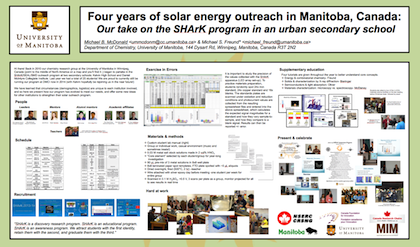S.H.Ar.K (Solar Hydrogen Activity Research Kit) is a program developed by Drs. Bruce Parkinson and Jennifer Schuttlefield at the University of Wyoming aimed at engaging keen students at the high school level in advanced, relevant scientific research. An interdisciplinary study involving the fields of materials science, electrochemistry and photophysics, students actively synthesize new materials to tackle arguably the greatest concern to humanity to date: clean, renewable sources of energy.
The sunlight that strikes the earth provides a hundred times that consumed by humans, even at the rapidly increasing levels currently being experienced and predicted in coming decades. We have photovoltaic (solar cell) technologies, but these are only useful when electricity is readily being consumed. It will be necessary to store energy captured by the sun into a fuel just as we pump gasoline into our cars but only use the energy stored in it when we drive.
We also do not want the waste products of the solar fuel to be greenhouse gas emitters. When hydrogen gas combusted, only water is produced as waste along with a lot of energy. However, producing enough hydrogen to satisfy energy needs on a global scale is challenging as it is energy intensive and uses expensive materials to catalyze (“drive”) the reaction. Essentially, it is just the reverse reaction of the combustion of hydrogen. Here, water which is cheap and abundant is split into hydrogen and oxygen using sunlight.
The most difficult step in making this economy viable is to discover materials powerful enough to perform the water splitting reaction with sunlight and be much, much more cost effective. This is where the S.H.Ar.K. program comes in! Given the millions and MILLIONS of combinations of the elements which can form materials, it would take scientists an impossible amount to time to engineer such a perfect catalyst. Taking a page from drug developers’ book where the challenge to find molecules to target very specific symptoms is equally painful, a combinatorial approach can be deployed for this as well. Here, several practically random elements are mashed together into a new material and tested for activity. The benefit of this is that, although lacking careful design and study, it is very fast to screen many new materials and cross them off the list of possibilities. However, if there is a good activity measured, the particular combination of elements can be more carefully analyzed until the “holy grail” of cheap catalyst is achieved!
In our afterschool sessions, students select three of their favourite elements and combine them in many (~60) ratios in spot plates. A small dot representing each unique combination is plotted onto a conductive sheet and it is fired to oxidize and precipitate the material. The sheet is then connected to an electrical circuit in water and placed over computer-controlled light sources. Here, LEDs shine on the spots and record data for each individually. The light energy on the material will catalyze the splitting of at least a very small amount of the surrounding water resulting in a very small current which is measured by the computer. The amount of current indicates how good the catalyst is. The whole process takes just five minutes and the combinations can be posted on the international S.H.Ar.K. website to see what has been done and what has both worked and not worked for others. If the currents are low then there is no time wasted studying them and new samples are made until we get a real hit. If that ever happens, true science takes effect and the result must be repeated. If the results are reproducible then more sophisticated instruments such as X-ray diffraction and spectroscopy can be used to probe the new chemical structure and understand why it works so well.
The work the students do leads to new and exciting results useful to the scientific community at even the highest levels, whether the materials are hits or not. Students gain valuable lab and critical thinking skills and learn about what it’s like to be a real scientist. This is all new science and all done by our own students in our own communities.






